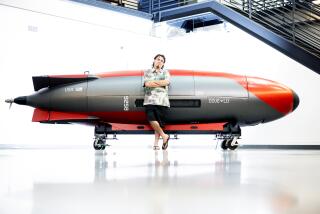Soaring Ambition : Lockheed Plans to Double Sales of Space Division
- Share via
SUNNYVALE — Lockheed built the top-secret military satellites used during the Cold War to spy on the Khrunichev weapons factory in Moscow, but today Lockheed executives are busy cutting a commercial deal with the same Russian operation.
The company’s space systems division, the largest U.S. producer of space equipment, is preparing to announce a major joint venture with the Moscow factory that would mark a new thrust in its commercial business.
The Khrunichev deal is part of an ambitious Lockheed growth plan to double its Sunnyvale-based space division revenue to $5 billion in the next eight years--despite a painful cutback in military spacecraft budgets that is likely to trigger an industry shakeout.
Lockheed intends to grab market share from weaker competitors and break the stranglehold on the commercial satellite market held by Hughes Aircraft, Loral and General Electric, company officials say.
“There are going to be winners and losers over the next few years, and we look at this chaotic time as an opportunity,” said Mel R. Brashears, vice president at the space systems division. “We believe there is enough opportunity in space to double our size by the year 2000.”
While Lockheed has gained attention recently for its $1.5-billion deal to buy General Dynamics’ aircraft business, the Calabasas-based company is pursuing an equally aggressive effort to bolster its enormous and highly profitable space business.
With $2.5-billion annual sales, the space unit is Lockheed’s largest single division, outstripping its two aircraft units combined. In 1991, the Lockheed Missiles & Space Co., which includes the space systems division, earned $360 million, or 63% of Lockheed’s operating profit.
But many industry experts are skeptical of Lockheed’s plan, noting that its military market is shrinking and that its commercial prospects hinge on the risky Iridium satellite communications system it is building for Motorola.
“With a shrinking market and 10 competing firms in the industry, it is hard to see Lockheed with a growing and profitable business in the next few years,” said Robert Paulson, director of McKinsey & Co.’s aerospace practice. “Lockheed is a class act, but it won’t come easy.”
Howard Rubel, aerospace analyst at C.J. Lawrence, Morgan Grenfell, added: “They may talk about doubling, but they are not investing for it. They are watching their capital. They are laying off people. There are still lots of bridges to cross.”
The space systems division has 8,500 employees, down 2,500 since 1987. Brashears hopes to recover those losses by 2000.
But Lockheed’s bold plan was dealt a rude setback last week when the Pentagon eliminated the firm from the Brilliant Eyes space defense program and its $1-billion sales potential, choosing instead Rockwell International and TRW/Grumman to develop competing designs for an early warning system.
While Lockheed Chairman Daniel Tellep admitted to being “disappointed,” he said Brilliant Eyes would have amounted to just 1% of Lockheed Missile & Space Co.’s annual revenue.
“It is not so significant that it would be a major loss to the company,” Tellep said. Indeed, the chairman said Lockheed has “an outstanding technical team” now aiming to win another “future early warning system” contract.
Even with the demise of the Cold War, much of Lockheed’s space business remains a puzzle. About half of its business is “black” programs--so secret their existence is not acknowledged. And the company is being nearly as tight-lipped about details of its Russian joint venture. Work for the National Aeronautics and Space Administration accounts for about 10% of the space unit’s revenue.
Unlike its competitors at Hughes Aircraft and TRW, Lockheed’s specialty is as an “integrator” of satellites, designing and building spacecraft but leaving instruments and electronics packages to subcontractors. Boeing and Martin Marietta are its main rivals.
With the military space industry in turmoil, it is unclear whether big integrators such as Lockheed or firms that build complete systems will emerge as the most successful, said John Harbison, a Booz Allen & Hamilton aerospace consultant.
Lockheed’s growth plan calls for increasing non-military work to 20% of sales and non-secret military business to 38%. That would require increasing its share of the $29-billion U.S. space market.
Lockheed believes that it could dominate industrial and commercial Earth observation from space--an obvious spin-off from its spy satellite business. Brashears noted that aerial photography is an $8-billion industry. For now, secrecy prevents Lockheed from even acknowledging that it builds such spacecraft.
The biggest gamble will be Iridium, the 66-satellite system that Lockheed isto build for Motorola. Brashears said Lockheed expects to be “fully underway” early next year, though Motorola awarded the contract in April, 1991, and has yet to finance the $3-billion worldwide mobile communications system.
Rivals at Hughes Aircraft, the dominant commercial satellite maker, consider Iridium fraught with risk, because its capacity will evenly blanket the globe while demand for its services will be concentrated in developed nations. And the whole system must go up before anybody knows how much demand it will generate.
But Brashears brushed aside such concerns, saying the whole point of Iridium is to create the first global network. “We aren’t blinking at all,” he said.
Lockheed Space Systems Division
Sales: About $2.5 billion in 1992.
Employment: 8,500 workers.
Main Plant: Sunnyvale, part of the Lockheed Missiles and Space Co.
Products: Largest producer of spacecraft, including the Central Intelligence Agency KH-11 spy satellite, the National Aeronautics and Space Administration Hubble Space Telescope, and the Air Force Milstar communications satellite.
Outlook: The division has set out an ambitious eight-year plan to double its revenues by moving into commercial markets and taking market share in government programs from its rivals.
More to Read
Inside the business of entertainment
The Wide Shot brings you news, analysis and insights on everything from streaming wars to production — and what it all means for the future.
You may occasionally receive promotional content from the Los Angeles Times.











